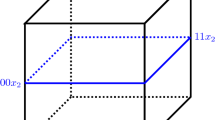Abstract
We present several applications of simple topological arguments (such as non-contractibility of a sphere and similar results) to Kolmogorov complexity. It turns out that discrete versions of these results can be used to prove the existence of strings with prescribed complexity with O(1)-precision (instead of usual O(logn)-precision). In particular, we improve an earlier result of M. Vyugin and show that for every n and for every string x of complexity at least n + O(logn) there exists a string y such that both C(x∣y) and C(y∣x) are equal to n + O(1). We also show that for a given tuple of strings x i (assuming they are almost independent) there exists another string y such that the condition y makes the complexities of all x i twice smaller with O(1)-precision. The extended abstract of this paper was published in [6].


Similar content being viewed by others
Notes
The plain Kolmogorov complexity C(x) of a bit string x is defined as the minimal length of a program that outputs x; this definition depends on the choice of a programming language, and we fix some language that makes the complexity minimal. The conditional complexity C(x∣y) is defined as the minimal length of a program that transforms y to x. The sum C(y) + C(x∣y) is equal to the complexity C(x, y) of (the encoding of) the pair (x, y) with logarithmic precision. The mutual information between x and y is defined as C(x) − C(x∣y), or C(y) − C(y∣x), or as C(x) + C(y) − C(x, y); all three quantities coincide with each other with logarithmic precision. Strings x and y are considered as “independent” if I(x : y) is negligible (of course, one has to specify the exact bound when formulating results about independent strings). The information distance between strings x and y is defined as C(x∣y) + C(y∣x); it satisfies the triangle inequality with logarithmic precision.
We assume that the reader is familiar with all these notions. An introduction to Kolmgorov complexity can be found, e.g., in [2, 7, 9]; see also an extensive textbook on this subject written by Li and Vitányi [3].
A better name would be Lipschitz continuity: if the distance between the images of neighbor grid points is bounded by c, then the distance between the images of arbitrary two points is at most c times bigger than the distance between the points itself (the distance is measured in l 1-sense)
References
Bauwens, B., Makhlin, A., Vereshchagin, N., Zimand, M.: Short lists with short programs in short time. In: Proceedings of the 28th IEEE Conference on Computational Complexity, pp 98–108 (2013)
Gács, P.: Lecture notes on descriptional complexity and randomness, http://www.cs.bu.edu/faculty/gacs/papers/ait-notes.pdf
Li, M., Vitányi, P.: An introduction to Kolmogorov complexity and its applications, 3rd edn. Springer Verlag (2008)
Muchnik, A.: Conditional complexity and codes. Chic. J. Theor. Comput. Sci. 271(1–2), 97–109 (2002)
Muchnik, A., Mezhirov, I., Shen, A., Vereshchagin, N.: Game interpretation of Kolmogorov complexity. arXiv:1003.4712
Romashchenko, A., Shen, A.: Topological arguments for Kolmogorov complexity, Proceedings of the 18th international workshop on cellular automata and 3rd international symposium Journées Automates Cellulaires, EPTCS, 90, p. 127–132, (2012)
Shen, A.: Algorithmic information theory and Kolmogorov complexity, technical report TR2000-034, Uppsala University, http://www.it.uu.se/research/publications/reports/2000-034
Shen, A.: Game arguments in computability theory and algorithmic information theory, Computability in Europe, 2012, LNCS 7318 p.655–666. Extended version (with Andrej Muchnik and Mikhail Vyugin). arXiv: 1204.0198 (2012)
Vereshchagin, N., Uspensky, V., Shen, A. Kolmogorov complexity and algorithmic randomness, 575 p. MCCME Publishers, Moscow (2012). For the electronic version and draft English translation see www.lirmm.fr/~ashen
Vyugin, M.: Information distances and conditional complexities. Theor. Comput. Sci. 271(1–2), 145–150 (2002)
Acknowledgments
The authors are grateful to Laurent Bienvenu who suggested to write down this simple argument, Tarik Kaced, and all the colleagues in Escape/NAFIT/Kolmogorov seminar team. We thank the (anonymous) referee for a very detailed review that pointed out many inaccuracies and suggested several improvements.
Author information
Authors and Affiliations
Corresponding author
Additional information
Both authors work at the LIRMM, CNRS & University of Montpellier 2 and are on leave from IITP RAS, Moscow. Supported in part by RFBR 14-01-93107 grant.
Rights and permissions
About this article
Cite this article
Romashchenko, A., Shen, A. Topological Arguments for Kolmogorov Complexity. Theory Comput Syst 56, 513–526 (2015). https://doi.org/10.1007/s00224-015-9606-8
Published:
Issue Date:
DOI: https://doi.org/10.1007/s00224-015-9606-8




